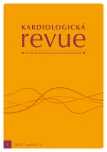Residual vascular risk and the global R3I (Residual Risk Reduction Initiative)
Authors:
H. Rosolová
Authors‘ workplace:
Centrum preventivní kardiologie II. interní klinika UK Praha, Lékařská fakulta v Plzni, Český institut metabolického syndromu, o. p. s.
Published in:
Kardiol Rev Int Med 2010, 12(1): 11-14
Overview
From a wider perspective, residual vascular risk might be understood as a risk resulting from inadequate risk factor management (cholesterol and LDL‑cholesterol, respectively, blood pressure and diabetes) as well as, certainly, inadequate life style management. In a more specific meaning of the word, this is a risk resulting from other alarming risk factors, particularly atherogenic mixed dyslipidemia, i.e. elevated triglyceride (TG) concentrations and low HDL‑cholesterol levels in patients with target LDL‑cholesterol values. And it is this very dyslipidemia that has become a focus of the global R3I (Residual Risk Reduction Initiative) launched in May 2008 in Budapest. This is a multidisciplinary non‑profit initiative, the aim of which is to improve and broaden the prevention of the most frequent diseases resulting from atherosclerosis as well as prevention of micro ‑ and macro‑vascular complications in type ‑ 2 diabetes. Key words: cardiovascular prevention – vascular risk – mixed dyslipidemia
Sources
1. Yusuf S, Hawken, Ounpuu S et al. INTERHEART Study Investigators. Effect of potentially modifiable risk factors associated with myocardial infarction in 52 countries (the INTERHEART Study): case ‑ control study. Lancet 2004; 364 : 937 – 952.
2. Baigent C, Keech A, Kearney PM et al. Cholesterol Treatment Trialists (CTT) Collaborators. Efficacy and safety of cholesterol ‑ lowering treatment: prospective meta‑analysis of data from 90,056 participants in 14 randomised trials of statins. Lancet 2005; 366 : 1267 – 1278.
3. Fruchart JC, Sacks FM, Hermans MP et al. Residual Risk Reduction Initiative (R3I).The Residual Risk Reduction Initiative: a call to action to reduce residual vascular risk in dyslipidaemic patients. Diab Vasc Dis Res 2008; 5 : 319 – 335.
4. Assmann G, Schulte H, Seedorf U. Cardiovascular risk assessment in the metabolic syndrome. Results from the Prospective Cardiovascular Münster (PROCAM) Study. Int J Obes 2008; 32: S11 – S16.
5. Ghandehari H, Kamal ‑ Bahl S, Wong ND. Prevalence and extent of dyslipidemia and recommended lipid levels in US adults with and without cardiovascula comorbidities: the National Health and Nutrition Examination Survey 2003 – 2004. Am Heart J 2008; 156 : 112 – 119.
6. Nordestgaard BG, Benn M, Schnohr et al. Nonfasting triglycerides and risk of myocardial infarction, ischemic heart disease, and death in men and women. JAMA 2007; 298 : 299 – 308. 7. Retnakaran R, Cull CA, Thorne KI. UKPDS Study Group. Risk factors for renal dysfunction in type 2 diabetes. UK Prospective Diabetes Study 74. Diabetes 2006; 55 : 1832 – 1839.
8. Tesfaye S, Chaturvedi N, Eaton SE et al. EURODIAB Prospective Complications Study Group: Vascular risk factors and diabetic neuropathy. N Engl J Med 2005; 352 : 341 – 350.
9. Jeon CY, Loken RP, Hu FB et al. Physical activity of moderate intensity and risk of type 2 diabetes. A systematic review. Diabetes Care 2007; 30 : 744 – 752.
10. Keech AC, Mitchell P, Summanen PA et al. the FIELD study investigators. Effect of fenofibrate on the need for laser treatment for diabetic retinopathy (FIELD Study): a randomised controlled trial. Lancet 2007; 370 : 1687 – 1697. [http:/ / www.thelancet.com/ journals/ lancet/ article/ PIIS0140673607616079/ abstract].
11. Buse JB, Bigger JT, Byington RP et al. ACCORD Study Group. Action to control cardiovascular risk in diabetes (ACCORD) trial: design and methods. Am J Cardiol 2007; 99 : 21i – 33i.
12. Brown BG, Zhao XQ, Chait A et al. Simvastatin and niacin, antioxidant vitamins, or the combination for the prevention of coronary disease. N Engl J Med 2001; 345 : 1583 – 1592.
13. Taylor AJ, Sullenberger LE, Lee HJ et al. Arterial biology for the investigation of the treatment effects of reducing cholesterol (ARBITER) 2. A double‑blind, placebo controlled study of extended ‑ release niacin on atherosclerosis progression in secondary prevention patients treated with statins. Circulation 2004; 110 : 3512 – 3517.
14. Cheng K, Wu TJ, Wu KK et al. Antagonism of the prostaglandin D2 receptor 1 suppresses nicotinic acid‑induced vasodilation in mice and humans. Proc Natl Acad Sci U S A 2006; 103 : 6682 – 6687.
15. Kastelein JP, Bots ML. Statin therapy with ezetimibe or niacin in high‑risk patients. N Engl J Med 2009; 361 : 2180 – 2183.
16. Rydén L, Standl E, Bartnik M et al. Task Force on Diabetes and Cardiovascular Diseases of the European Society of Cardiology (ESC) and of the European Association for the Study of Diabetes (EASD): Guidelines on diabetes, pre‑diabetes, and cardiovascular diseases:executive summary. Europ Heart J 2007; 28 : 88 – 136.
Labels
Paediatric cardiology Internal medicine Cardiac surgery CardiologyArticle was published in
Cardiology Review

2010 Issue 1
Most read in this issue
- Carvedilol as a treatment option for cardiovascular diseases
- Depression in patients with cardiovascular disease
- Tenecteplase in current clinical practice
- New players on the antiplatelet therapy chequerboard – what can we expect?
